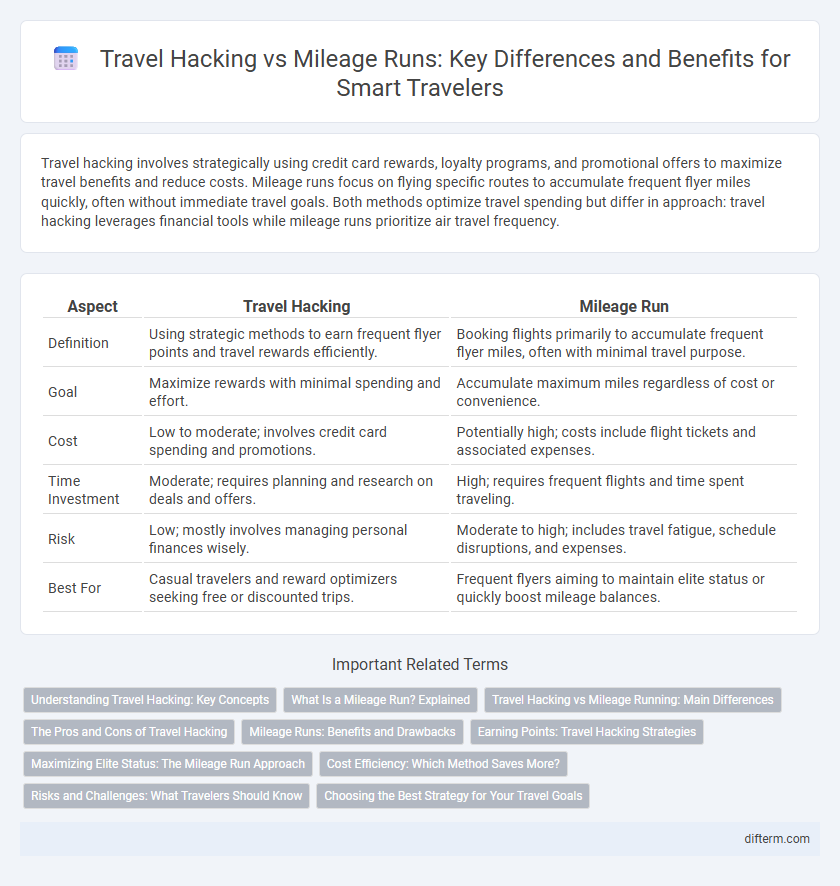Travel hacking involves strategically using credit card rewards, loyalty programs, and promotional offers to maximize travel benefits and reduce costs. Mileage runs focus on flying specific routes to accumulate frequent flyer miles quickly, often without immediate travel goals. Both methods optimize travel spending but differ in approach: travel hacking leverages financial tools while mileage runs prioritize air travel frequency.
Table of Comparison
| Aspect | Travel Hacking | Mileage Run |
|---|---|---|
| Definition | Using strategic methods to earn frequent flyer points and travel rewards efficiently. | Booking flights primarily to accumulate frequent flyer miles, often with minimal travel purpose. |
| Goal | Maximize rewards with minimal spending and effort. | Accumulate maximum miles regardless of cost or convenience. |
| Cost | Low to moderate; involves credit card spending and promotions. | Potentially high; costs include flight tickets and associated expenses. |
| Time Investment | Moderate; requires planning and research on deals and offers. | High; requires frequent flights and time spent traveling. |
| Risk | Low; mostly involves managing personal finances wisely. | Moderate to high; includes travel fatigue, schedule disruptions, and expenses. |
| Best For | Casual travelers and reward optimizers seeking free or discounted trips. | Frequent flyers aiming to maintain elite status or quickly boost mileage balances. |
Understanding Travel Hacking: Key Concepts
Travel hacking involves strategically using credit card rewards, loyalty programs, and promotions to maximize travel benefits without excessive spending. Mileage runs consist of booking flights solely to accumulate frequent flyer miles and elite status, often requiring time and financial investment. Understanding the key concepts of travel hacking helps travelers efficiently earn points, redeem rewards, and optimize travel experiences.
What Is a Mileage Run? Explained
A mileage run is a strategic flight taken solely to accumulate frequent flyer miles or elite status, often involving inexpensive or inconvenient routes. Travelers use mileage runs to reach higher tier benefits such as lounge access, priority boarding, and bonus rewards faster. Unlike general travel hacking, which includes diverse tactics like credit card points and promotions, mileage runs specifically focus on maximizing miles through actual flight segments.
Travel Hacking vs Mileage Running: Main Differences
Travel hacking focuses on strategically using credit card rewards, loyalty programs, and promotions to maximize travel benefits with minimal expenses, while mileage running involves booking flights solely to accumulate frequent flyer miles regardless of cost or destination. Travel hacking emphasizes long-term value through point accumulation and redemption across various platforms, whereas mileage running centers on short-term mileage gains often through repetitive flight segments. Understanding these differences helps travelers optimize their approach to earning rewards based on goals, budget, and travel frequency.
The Pros and Cons of Travel Hacking
Travel hacking offers substantial benefits such as maximizing airline miles, earning valuable credit card rewards, and accessing exclusive travel perks without excessive spending. However, it requires careful management to avoid pitfalls like credit score impact, annual fees, and potential complications with airline loyalty programs. Balancing strategy and discipline is essential to fully leverage travel hacking while minimizing financial and logistical risks.
Mileage Runs: Benefits and Drawbacks
Mileage runs offer travelers a strategic way to accumulate frequent flyer miles by booking flights primarily for distance rather than destination, maximizing rewards for future travel redemptions. Benefits include rapid miles accumulation that can lead to elite status upgrades, free flights, and access to airport lounges, while drawbacks encompass high costs, time consumption, and potential travel fatigue. Careful budget analysis and itinerary planning are essential to ensure mileage runs provide net value without excessive financial or personal strain.
Earning Points: Travel Hacking Strategies
Travel hacking leverages credit card sign-up bonuses, shopping portals, and promotional offers to accumulate points efficiently without extensive travel. Mileage runs involve booking flights specifically to earn elite status or reward miles, often requiring significant time and expense. Combining travel hacking with strategic mileage runs maximizes point accumulation and accelerates loyalty program benefits.
Maximizing Elite Status: The Mileage Run Approach
Mileage runs focus on accumulating elite status miles rapidly by targeting cheap flights with long distances, making it a strategic method for maximizing elite status more efficiently than general travel hacking. Elite status unlocks benefits like priority boarding, lounge access, and bonus miles, which enhance the travel experience and increase future earning potential. Frequent flyers use mileage runs to meet airline thresholds quickly, especially during status qualification periods, optimizing the value of their travel spend.
Cost Efficiency: Which Method Saves More?
Travel hacking leverages credit card sign-up bonuses, loyalty programs, and strategic bookings to maximize rewards at a low cost, often requiring minimal actual travel expenses. Mileage runs involve taking flights solely to accumulate frequent flyer miles, which can be costly due to airfare and taxes but may offer significant mileage gains for elite status. Evaluating cost efficiency, travel hacking generally saves more money by earning valuable points without extensive spending, whereas mileage runs can result in higher out-of-pocket costs despite potential elite benefits.
Risks and Challenges: What Travelers Should Know
Travel hacking involves strategizing credit card rewards and promotions to maximize points but carries risks such as credit score impact and potential fraud. Mileage runs require flying multiple short trips solely to accumulate frequent flyer miles, which can lead to high costs, fatigue, and unpredictable schedule disruptions. Both methods demand careful planning to avoid financial losses and ensure alignment with personal travel goals.
Choosing the Best Strategy for Your Travel Goals
Travel hacking leverages credit card rewards, promotions, and strategic spending to maximize points and miles efficiently, while mileage runs focus on accruing frequent flyer miles through flying specific routes regardless of cost or convenience. Choosing the best strategy depends on your travel goals: if you aim for high-value redemptions and credit score benefits, travel hacking suits you; if your priority is accumulating elite status or topping up miles quickly, mileage runs remain effective. Evaluating factors such as budget, time availability, and desired airline loyalty programs ensures alignment with the optimal approach.
travel hacking vs mileage run Infographic

 difterm.com
difterm.com